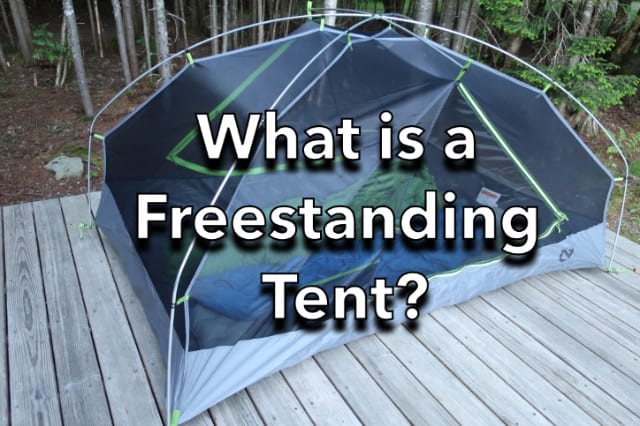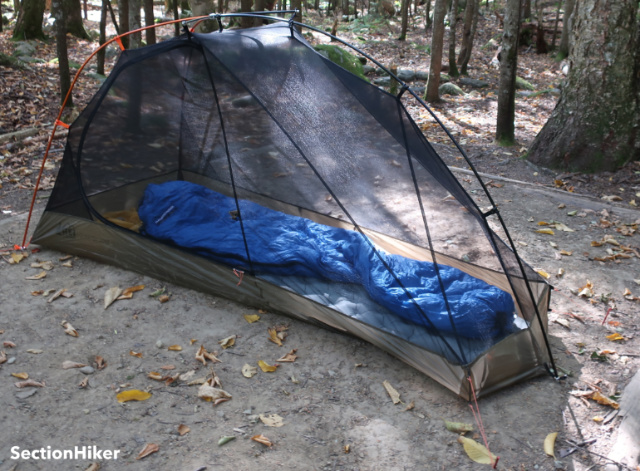
Freestanding tents are tents that can stand up by themselves (the poles slot into the four corners) making them easy to set up in different types of terrain from desert sands and snow-covered peaks to wooden tent platforms. Most freestanding tents are double-wall tents that have a separate inner tent and a rainfly to help prevent internal condensation from making your gear wet, although a handful of single-wall freestanding tents also exist, designed mainly by climbers and mountaineers.

If you’re shopping for a freestanding tent, you’re bound to come across some that are classified as semi-freestanding. Semi-freestanding tents are also freestanding but require several tent stakes to set up — mainly to stake out the corners which aren’t stretched taut by poles. It’s a subtle distinction and not a terribly meaningful one since you should always stake out a tent to prevent it from blowing away in the wind or in bad weather. Even if tent stakes can’t be used, you should still anchor a tent with rocks or by burying tent stakes in the ground using sand stakes or deadmen. See How to Set up a Tent on Sand for more information on this topic.
Freestanding tents can be further broken down into three categories, which we describe in greater detail below:
- Double-wall tents where the Inner Tent is set up first
- Double-wall tents where the Rainfly is set up first
- Single-wall tents
Here are some examples of each type:
| Make / Model | Design | Setup | Weight |
|---|---|---|---|
| Big Agnes Copper Spur HV UL2 | Freestanding | Inner Tent First | 2 lbs 11 oz |
| Big Agnes Tiger Wall UL 2 | Semi-Freestanding | Inner Tent First | 2 lbs 3 oz |
| Nemo Hornet Elite 2 | Semi-Freestanding | Inner Tent First | 1 lb 11 oz |
| Big Agnes Fly Creek UL 2 | Semi-Freestanding | Inner Tent First | 1 lb 15 oz |
| MSR Hubba Hubba 2 | Freestanding | Inner Tent First | 3 lbs 8 oz |
| Paria Outdoor Zion 2P | Freestanding | Inner Tent First | 4 lbs 2 oz |
| SlingFin Portal 2 | Freestanding | Inner Tent First | 2 lbs 13 oz |
| Hilleberg Niak | Freestanding | Rainfly First | 3 lbs 5 oz |
| Hilleberg Unna | Freestanding | Rainfly First | 4 lbs 7 oz |
| Terra Nova Southern Cross 1 | Freestanding | Rainfly First | 3 lbs 4 oz |
| Big Sky Chinook 2 | Freestanding | Rainfly First | 4 lbs |
| Black Diamond Firstlight 2 | Freestanding | Single Wall | 3 lbs |
| MSR Advance Pro 2 | Freestanding | Single Wall | 2 lbs 14 oz |
Double-Wall: Inner Tent First
Most of the semi-freestanding tents made by US-based manufacturers like Big Agnes, MSR, NEMO, REI, and others require that you set up the inner tent first and then drape the rainfly over it. This is a very easy process, which is why the tents that use it are so popular.

You simply stake out the corners of the inner tent, expand the poles and insert them into grommets in the corners, and then hook the walls and ceiling of the inner tent to the poles so the structure stands up by itself. The rainfly gets laid on top and usually connects the corners of the inner tent. The vestibule doors usually have to be staked out, but this usually only requires 1-2 tent stakes but if the poles slot into the corners of the inner tent, it’s usually classified as freestanding.

This inner tent first design works well in dry weather, but it can result in a wet inner tent if you have to set it up while it’s raining. But worst comes to worst, you can usually mop up any rain that penetrates the mesh ceiling of the inner tent with a camping towel and use the tent as normal.
Double-Wall Tents: Rainfly First
Many European-made tents including the fully freestanding and semi-freestanding tents made by Hilleberg, Exped, and Terra Nova are set up rainfly first. The tent poles slide into sleeves sewn into the rainfly fabric and the inner tent is suspended under the rainfly. In dry weather, you can also leave the rainfly and inner tent attached when you take down the tent, so the entire structure does up at once the next time you pitch the tent,

While the rainfly-first design prevents rain from making the inner tent wet, this type of tent is generally heavier than those that get set up with the inner tent first. These tents are also generally much more expensive because they’re more difficult to manufacture and made with more durable materials.

Single-Wall Freestanding Tents
There are also single-wall freestanding tents that don’t have a separate inner tent and rainfly but have a single skin. These are often fully freestanding and mainly designed for climbers and mountaineers who need tents that are easy to set up on narrow rock ledges in adverse winter conditions where staking out a tent would be impossible.

The tent poles in this style of tent usually criss-cross inside the tent and you need to crawl inside to insert them in the tent corners. While these tents are very lightweight and convenient to use in cold winter weather, they tend to have poor ventilation and are subject to heavy internal condensation unless all the doors and windows are left wide open.
 SectionHiker.com Backpacking Gear Reviews and FAQs
SectionHiker.com Backpacking Gear Reviews and FAQs
The list gives the impression that freestanding tents are a lot more expensive & heavier which isn’t necessarily true. Example the Big Agnes Copper Spur.
If setting up a tent inside a lean-to or large covered tent platform, only a free standing or semi-free standing tent will work. Staking out the vestibules is probably unnecessary. The flaps can simply be tied back. There are specially made tent stakes for use on wood floored shelters but most people don’t carry them. They would be necessary for a tent which is not free standing.
Actually, you just need these special tent stakes for pitching tents on wooden platforms. Much less expensive.
Thanks for the information on tents. I’m always looking for lightweight one person tent information.
The last decade I’ve been using mostly single rainbow tents because their size is large for a one person and they are semi-free standing if you use trekking poles. They set up taught and inside stays dry when setting up in the rain.
Since this is kind of a specialty niche using the trekking poles I thought I would add this as a comment to your review of tents.
I’ve been considering the Rainbow for the freestanding/trekking pole feature you mention. I have a lightweight trekking pole supported tent (The One), but sometimes stacking rocks on all my stakes to keep my tent up is a chore I would rather not have to deal with. Grandpa posts he wasn’t impressed with the Rainbow in this mode. I would only consider the weight penalty of the Rainbow if the freestanding mode (I understand the vestibule still needs staking) is effective. What has been you’re experience using the Rainbow as a freestanding shelter?
I concur with Grandpa. For that weight, you can get a BA Copper Spur HV UL1 and never stack rocks again.
I was wondering about that semi-freestanding thing…thanks.
I just put in a season (March – Nov. in Colorado at all altitudes) with TarpTent’s new Bowfin, a double-walled freestanding. I really am enjoying its adaptability, while still being pretty simple. Its standard pitch is inner wall first.
But it has a pretty ingenious option to set it up in one piece when it’s raining. I’m still playing around with it — and haven’t truly tested it in rain — but it sets up pretty well. You have to think to do a bit of pre-setting (hooking the tent to the fly and putting a cross pole at the peak on the outside rather than the inside). So you either have to anticipate needing it, or duck into a dry spot to pre-rig to get the full benefit in the rain. I think if I were in a rainy spell, I’d just plan ahead to set it up that way. It’s not quite as easy as the standard pitch, but seems like it would be worth it to keep my nest dry!
Except for freestanding tents where you can keep the two linked together when you pack them and set them up at the same time (for example, many models of Hilleberg, Tarptent). If they’re dry when you pack them, they’ll be dry when you set them up. You only need to separate the when the outer is wet at the time of packing.
Is there a truly freestanding tent, double-wall, that doesn’t cost a fortune? I am in the South, so condensation is real! I am looking for a lightweight (or reasonably light-weight) tent that I can set up in a shelter. My Big Agnes FlyCreek 2 is only semi- freestanding. Does such a tent exist- again that doesn’t cost a fortune?
You realize, you only need to set up the inner tent in the shelter…
Even then, you’re really not supposed to do that. It’s considered bad etiquette to hog up a shelter with a tent designed fo people to sleep on the floor.
But if you’re looking for lightweight double-wall tents take a look at Big Sky International.
Stole that from a reader named Eddie who’s been using it for years on this website. He’s finally got me saying it too!